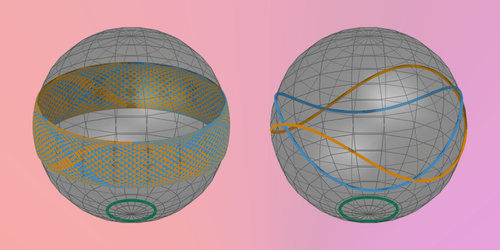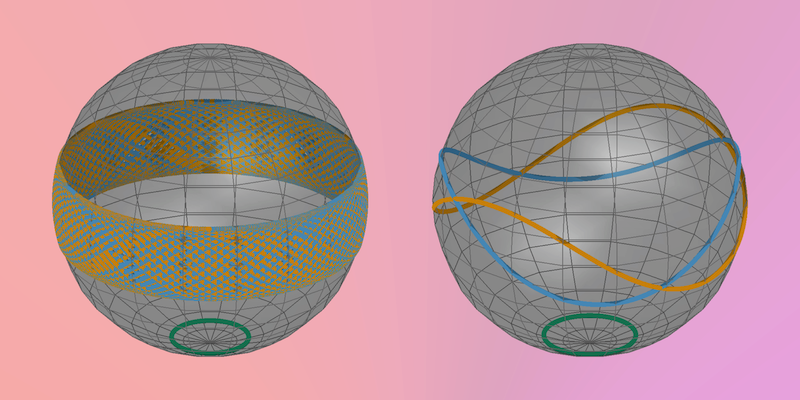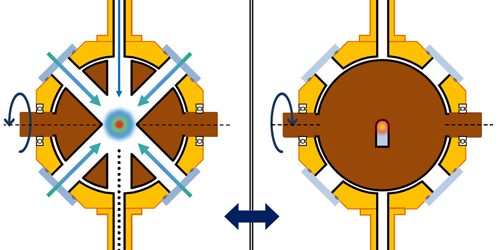- Gunnar Jeschke
- Department of Chemistry and Applied Biosciences, Swiss Federal Institute of Technology (ETH) Zurich, Zurich, Switzerland
August 11, 2025• Physics 18, 145
A radio-frequency field can be resonant with nuclear spins in a sample even if its frequency does not match a spectroscopic transition—a result that could enable new forms of NMR spectroscopy.
G. Jeschke/ETH Zurich
Figure 1: In a doubly rotating frame, the spin vector of uncoupled spins is at rest. For irradiation that is 10% below the nonsecular resonance (left), the vector samples a broad range of orientations. But at nonsecular resonance (right), it moves on a closed trajectory. The difference in trajectory means that the nonsecular components of the coupling average out in the former but not in the latter case. In the latter case, they thus cause loss of the nuclear magnetization.
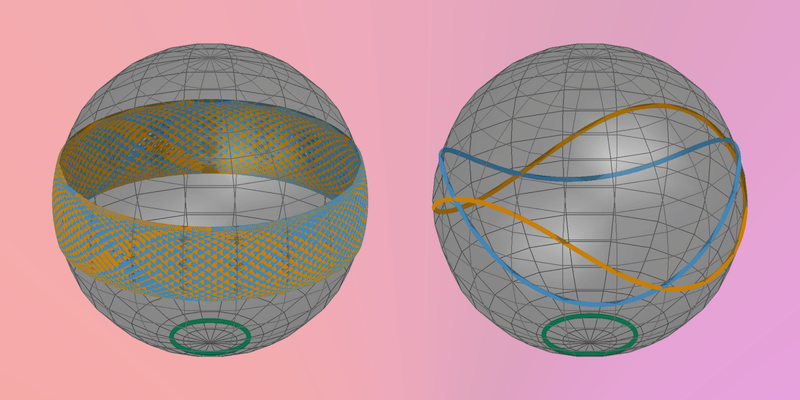
G. Jeschke/ETH Zurich
Figure 1: In a doubly rotating frame, the spin vector of uncoupled spins is at rest. For irradiation that is 10% below the nonsecular resonance (left), the vector samples a broad range of orientations. But at nonsecular resonance (right), it moves on a closed trajectory. The difference in trajectory means that the nonsecular components of the coupling average out in the former but not in the latter case. In the latter case, they thus cause loss of the nuclear magnetization.×
Physical systems often have characteristic frequencies. When excited at such a frequency, they start to resonate. The Broughton Suspension Bridge incident on April 12, 1831, showed how this can go wrong. A detachment of 74 riflemen marched in step over the bridge, accidentally matching its resonance frequency. Before they had crossed, the bridge collapsed. At the much-smaller scale of nuclear magnetic resonance (NMR) spectroscopy, resonant excitation is less dramatic yet very useful. Typically, NMR relies on secular resonance, which occurs when the energy of the radio-frequency photons used in a measurement matches the energy required for flipping the magnetic moment of a nucleus in a static magnetic field. This secular resonance occurs at the so-called Larmor frequency. Structure determination of chemical compounds, experimental observation of protein dynamics, and magnetic resonance imaging rely on this matching. Now Michael Jurkutat and his colleagues from the Karlsruhe Institute of Technology and the University of Leipzig—both in Germany—have demonstrated a new type of NMR that is based on nonsecular resonance, meaning that the resonance can occur far off the Larmor frequency [1]. Again and again, the physics of magnetic resonance has been announced to be mature. This new study demonstrates that even basic phenomena can still be discovered in this old field. Among the anticipated applications of the result are new schemes for enhancing sensitivity of NMR of one element by irradiating an isotope of another element and new ways of characterizing the structure of solid materials.
For a nucleus in a static magnetic field, the secular resonance frequency is calculated from the strength of the field and from the magnetic moment of the nucleus [2]. In the absence of radio-frequency irradiation, magnetization from the nuclear spins is parallel to the static field and at rest. On resonant irradiation, the magnetization vector departs from its equilibrium orientation and starts a spiral motion. The spiral arises from precession of the magnetization vector about the direction of the total magnetic field. The total magnetic field results as the sum of the static field and the magnetic component of the radio-frequency field. The nuclear spins precess at their Larmor frequency. If the radio frequency matches the Larmor frequency, spin motion and field direction remain in step. Thus, resonant, secular excitation of the spins occurs.
This common type of spin resonance arises from secular components of the interactions of the spin with the magnetic field and with other spins. Secular components contribute to the splitting of the energy levels of spins. In a strong magnetic field, a nucleus aligns its spin either parallel to the field (the lower-energy 𝛼 state) or antiparallel (the higher-energy 𝛽 state). For spin-1/2 particles, secular interactions split the energy levels of the 𝛼 and 𝛽 states. The Larmor frequency is this energy splitting divided by Planck’s constant. For two coupled fluorine-19 (19F) nuclei, the secular component of the magnetic dipole–dipole coupling parallel to the static field combines with the secular Zeeman interaction. But the coupling also has nonsecular components. Nonsecular components have no significant influence on the energy levels of spins, nor do they affect the intensity of the usually observed resonances. While predicted theoretically, nonsecular components have hitherto been invisible in experiments. In a frame where the irradiation field becomes time independent, the nonsecular couplings average out (Fig. 1).
In their new experiment, Jurkutat and his collaborators demonstrated that these otherwise hidden nonsecular components could nevertheless cause a resonant change of nuclear magnetization. Crucial first steps toward the new result were taken in 2012 by theorists who identified the conditions under which nonsecular resonances could become manifest [3]. In 2016 they realized that fluorite (CaF2) is well suited for observing nonsecular resonance [4]. This is because the 19F nuclei in this mineral have large magnetic moments. What’s more, next-neighbor nuclei are close, which leads to large magnetic dipole–dipole couplings. The theorists went on to suggest an experiment in which the radio frequency would be switched from the secular resonance at the Larmor frequency to the nonsecular resonance condition at about twice the Larmor frequency.
Jurkutat and collaborators succeeded by performing the proposed experiment in a different way. Instead of switching the frequency from a secular to a nonsecular condition, they applied magnetic-field jumps and performed all the irradiation at the same frequency. After a first jump to a field higher than the secular resonance condition, sufficient thermal polarization of the 19F spins built up to enable the effect to be observed. Another jump to about half the field of the secular resonance condition established nonsecular resonance. At this field the sample was irradiated for a while. After a third jump to the secular resonance condition, the 19F nuclear spins could be conveniently observed by conventional NMR. By varying the second magnetic field, Jurkutat and collaborators finally found the nonsecular resonance by observing a strong resonant decrease in the NMR signal.
Nonsecular resonance was not observed earlier because it is too weak when the oscillatory field’s amplitude is less than 1% of the static field’s. Jurkutat and his collaborators could cross this threshold thanks to their ingenious field-jump experiment.
An intriguing new direction involves extending their ideas to electron paramagnetic resonance (EPR), a technique that’s particularly useful for studying compounds with unpaired electrons, such as free radicals, which play an important role in biology and chemistry. In EPR, a similar effect may be easier to observe because electron spins have much-larger magnetic moments and interact more strongly with electromagnetic fields. Unlike in NMR spectroscopy, measurements in the 4- to 50-K temperature range are common in EPR spectroscopy. This leads to much-higher thermal polarization and thus to higher sensitivity. In many cases, EPR spectroscopy lagged NMR spectroscopy in performing certain experiments because the higher frequencies required for EPR are more challenging for instruments. Some of the EPR experiments that followed their NMR precursors went on to find broad applications in EPR. Nonsecular resonance may well turn out to be the next such case.
References
- M. Jurkutat et al., “Nuclear magnetic resonance far off the Larmor frequency: Nonsecular resonances in CaF2,” Phys. Rev. B 112, L060302 (2025).
- A. Abragam et al., Principles of Nuclear Magnetism (Oxford University Press, Oxford, 1961)[Amazon][WorldCat].
- C. M. Kropf and B. V. Fine, “Nonsecular resonances for the coupling between nuclear spins in solids,” Phys. Rev. B 86, 094401 (2012).
- C. M. Kropf et al., “Anomalous longitudinal relaxation of nuclear spins in CaF2,” Fortschr. Phys. 65, 1600023 (2016).
About the Author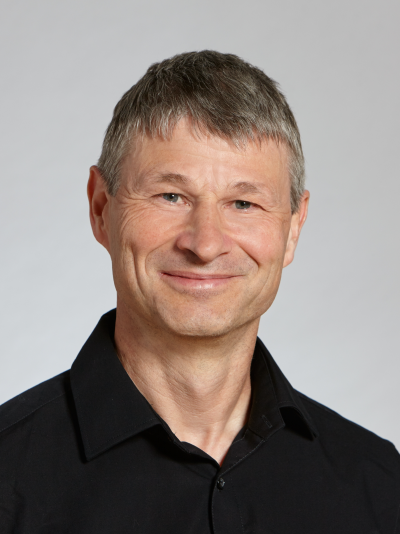
Gunnar Jeschke graduated from TUD Dresden University of Technology, Germany, with a diploma thesis in the field of solid-state nuclear magnetic resonance (NMR) and obtained a doctoral degree from the Swiss Federal Institute of Technology (ETH) Zurich in 1996 with a thesis on electron paramagnetic resonance (EPR) spectroscopy. After working with NMR spectroscopy on inorganic materials at the University of Bonn and with EPR spectroscopy on synthetic polymers and membrane proteins at the Max Planck Institute for Polymer Research, he became a full professor of physical chemistry at the University of Konstanz in 2006 and at ETH Zurich in 2008. His interests range from spin quantum phenomena via heterogeneous catalysis to disorder phenomena in proteins.
Subject AreasAtomic and Molecular PhysicsQuantum InformationRelated Articles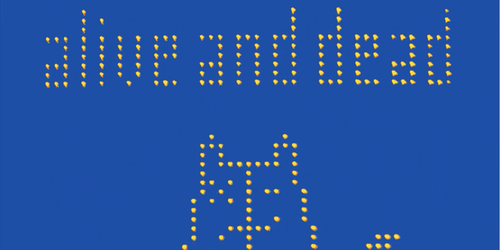 Atomic and Molecular PhysicsCat Video Made with AtomsAugust 8, 2025
Atomic and Molecular PhysicsCat Video Made with AtomsAugust 8, 2025
To demonstrate a new system for rapidly rearranging thousands of atoms, researchers produced an animation featuring Schrödinger’s famous feline. Read More »
 Quantum InformationBridging the Quantum Frequency GapAugust 6, 2025
Quantum InformationBridging the Quantum Frequency GapAugust 6, 2025
A new device can freely and efficiently change the frequency of microwave signals, enabling communication between otherwise incompatible quantum systems. Read More »
